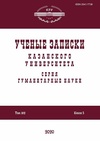Трудности советской урбанизации и создания «социалистического города» на мультикультурной периферии: Казань 20-х годов XX века
Difficulties of Soviet urbanization and construction of the “socialist city” in the multicultural periphery: Kazan in the 1920s
Author(s): Thomas M. Bohn, Svetlana Yu. Malysheva, Alla Arkadevna SalnikovaSubject(s): Architecture, Political history, Social history, Nationalism Studies, Rural and urban sociology, Interwar Period (1920 - 1939)
Published by: Казанский (Приволжский) федеральный университет
Keywords: urbanization; multiculturality; “socialist city”; “indigenization”; national policy; Kazan; Soviet Russia; 1920s;
Summary/Abstract: Based on the example of Kazan in the 1920s, the difficulties and problems of implementing the Soviet policy of urbanization and “socialist city” construction in cities with a nationally and religiously heterogeneous population are shown. This policy and the related processes of rural-urban migration, “indigenization”, “apartment redistribution”, and development of the urban outskirts at the expense of the former “bourgeois” center destroyed, deliberately and purposefully, the urban culture that had previously prevailed here and changed the social and national composition of the urban population. Therefore, they can be regarded as the tools of “positive discrimination”. The “positive discrimination” of the formerly dominant urban Russian culture in favor of the developing Tatar culture, mostly in its rural variant, manifested itself very clearly in education, namely in the content and design of the Soviet Tatar alphabet (alifba). However, the practice of granting preferences to the previously discriminated strata turned out to be short-term, tooled for the tasks of immediate strengthening of the social base of the Soviet power, and designed to destroy the former society and culture. These practices of dealing with multiculturalism became less popular by the late 1920s–early 1930s, as the Bolshevik power stabilized and “state-oriented” and unifying tendencies in the power policy increased.
Journal: Ученые записки Казанского университета. Серия Гуманитарные науки
- Issue Year: 163/2021
- Issue No: 3
- Page Range: 226-240
- Page Count: 15
- Language: Russian

